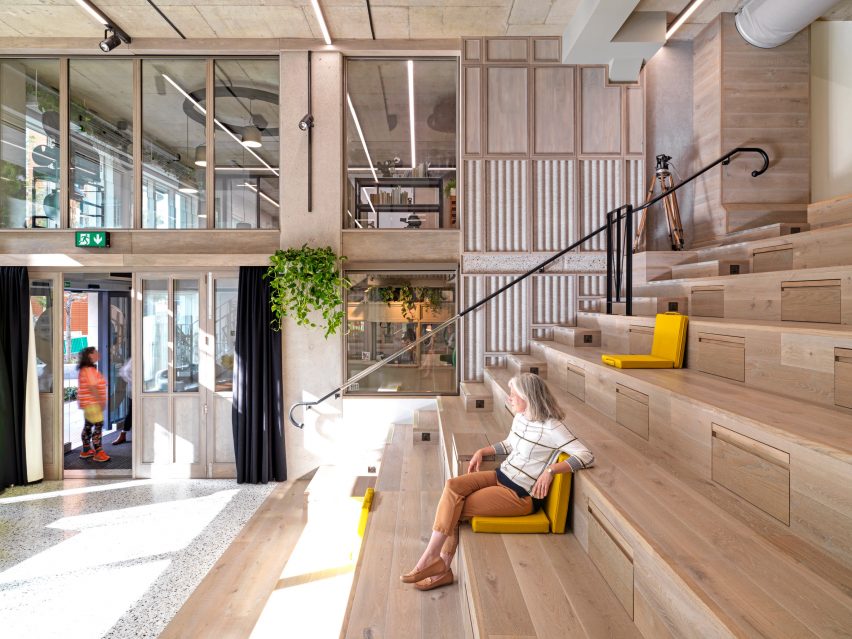
Threefold Architects unveils a model for post-Covid co-working
Threefold Architects has completed Paddington Works, a co-working and events space in London that was designed around wellness principles.
Paddington Works combines a mix of spaces that include private studios, shared co-working spaces, meeting rooms and a multi-purpose auditorium, all arranged over two storeys.

Workspaces are designed to be agile, providing different spaces to suit various activities. There are also a range of health-conscious building services, such as fresh air filtration and adaptive lighting systems.
At a time when many co-working offices are trying to adjust to the changes in work habits prompted by the Covid-19 pandemic, this project offers a model for the future of shared workspaces.

"I think co-working spaces could thrive if they adapt following the pandemic," said Matt Driscoll, one of the three co-founders of Threefold Architects.
"So much time spent working at home has brought into sharp focus the simple things we take for granted that are vital to our wellbeing," he told Dezeen.
"A moment to gaze out the window, an escape from Zoom for a walk in the park, impromptu chats with our neighbours; we will attribute far greater importance to these small things."

Paddington Works builds on Threefold's research into how incorporating wellness principles into architecture can create healthier and happier environments, which has previously fed into workspace designs for Airbnb and Pocket Living.
These principles were central to the design brief, even though Paddington Works was designed long before the pandemic.
The air circulation system, which includes anti-viral filtration, is designed to bring 25 per cent more fresh air into the building than is typical.
Meanwhile the lighting system uses intelligent LEDs to adjust the colour temperature of the light throughout the day, to suit circadian rhythms.

The layout of the interior, organised over two storeys, was also designed with occupants in mind. Spaces are divided up into clusters to allow small communities to form within the building.
Each cluster has its meeting rooms and breakout spaces, organised around a kitchen and social space.
"I think many of the principles of wellness are intuitive to architects – providing good natural light, visual amenity, excellent acoustics, and air quality," said Drisscoll.

"Beyond how the spaces feel, we are also interested in how they will be used and how people move around them and interact with each other," he continued.
"There should be quiet places to be alone, vibrant places to collaborate, and everything in between. We've always put generous social spaces at the heart of our schemes, for people to come together in their downtime, spaces to support, create and promote a culture within a business."

At the heart of the scheme is a flexible auditorium, designed as a huge set of wooden steps. The space can be used to host lectures, screenings and presentations, but it can also be a day-to-day informal work or meeting space.
Each step incorporates a series of pull-out "drawer desks", which can be used for laptops or notebooks. There are also power points for charging devices.
"It doubles as a staircase between the levels and becomes a type of forum, a public space within the building," explained Drisscoll.

The materials palette responds to the industrial heritage of the Paddington Basin area, with steel fabrications that recall the structure of the Brunel-designed train station. These are paired with textural materials like rough-sawn oak and terrazzo.
Many of the industrial elements of the design are concealed, for instance, perforated metal screens cover the air filtration units.

Paddington Works is a joint venture between co-working operator Space Paddington and Westminster Council, aimed at startups in the creative and technology industries.
As a result of its wellness-focused design, the building was able to adopt social distancing and hygiene measures brought in by the pandemic. Contactless hand sanitisers and anti-microbial fittings were among features already included in the design.
Drisscoll believes co-working spaces like this one will continue to become more common in the future, as companies look to adopt more flexible working models for their staff.

"I think flexible working is here to stay," he said. "Previously reticent organisations have seen it can work and work well; people enjoy more control of what they do."
"We may see a trend towards decentralisation – large organisations with acres of office and fields of desks could shift towards smaller workplaces," he added.
"This could see an increase in local work hubs, with co-working spaces in residential areas providing excellent places for work closer to home, and spaces close to major transport hubs allowing people to easily travel to from distance to get together."
Photography is by Charles Hosea.